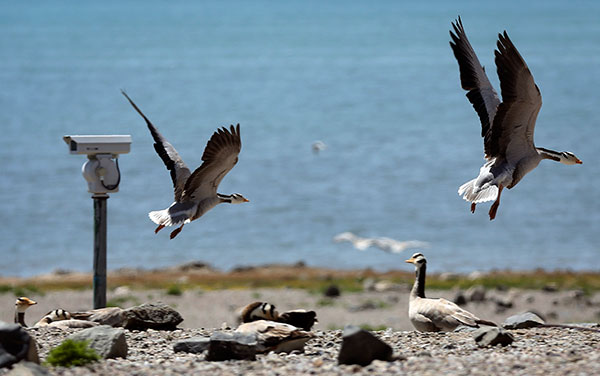|
 |
|
Flocks of cormorants nesting on Bird Island at the Qinghai Lake National Nature Reserve. [Photo by Wang Jing/China Daily] |
Warning signs
Although the work is routine, Li understands its importance. He was among one of the first people to spot signs that heralded an outbreak of avian flu in 2005.
"I noticed that some of the bar-headed geese were vomiting fluids, and their feathers were fluffy. Some simply fell out of the sky," he said.
Samples were sent to institutes in Xining and Beijing for examination, and the birds were later found to be the first cases of a highly pathogenic strain of avian flu. In less than two weeks, more than 6,000 birds died, including nearly 1,000 bar-headed geese, one-tenth of the population. Other major species, such as brown-headed gulls and cormorants, were also affected. The birds were treated effectively, even though the cause of the disease was still unknown.
From 2007 to 2008, the reserve conducted research into the flu with the Computer Network Information Center of the Chinese Academy of Sciences and the US Geological Survey.
The study used GPS trackers to determine the birds' migratory routes to and from the lake. "It answered many of our questions, and will definitely help us better protect the birds," Li said.
In the past, he and his colleagues regularly patrolled the habitats to study the birds and ensure their safety. They stayed overnight in temporary shelters and used binoculars to observe the birds, but the harsh environment made data collection a challenge.
In 2006, the reserve's administration cooperated with CAS to set up a live video-monitoring system. Coverage was limited initially, but the area under observation has gradually expanded and equipment upgrades have improved the image quality. More than 30 cameras have now been installed in six core areas of the reserve, including eight on Bird Island.
"The advanced monitoring system helps us to keep accurate records. We can observe the birds mating and hatching without walking out of the door," Li said.
Hou Yuansheng, from the reserve's IT department, said much of the research and protection work would be impossible without the system and similar technology. Constant monitoring has allowed more than 30 bird species to be added to the list of species in the reserve, and the overall number of species has risen to 222, he said.
The data is simultaneously stored in a local database, owned by the administration, and at CAS' offices in Beijing.
The system, which automatically classifies the videos according to species, has also helped researchers produce a number of scientific theses. "It collects a massive volume of data, so it's hard for us to analyze all of it," Hou said. "With further upgrades, the live videos will finally be available online, and we'd like to invite netizens who are interested in studying the birds to observe and analyze the videos."
Li said the monitoring system has also helped to prevent disturbances caused by fishermen, who used to cast their lines close to the habitats and also picked up eggs, and wild animals.
"Human disturbance is more destructive for breeding birds than diseases or natural enemies, but the cameras deter the fishermen, so the birds' habitats are safe now," he said.
A range of measures has been taken to protect the birds on the island, including the construction of a 900-sq-m observation room and the 450-meter-long "eco-passage" fitted with windows for tourists. The moves have reduced the impact of tourism on the birds' habitat.
To compensate for the effects of the shrinking habitat as the water level rises, the administration has built eight artificial islands. More than 40 artificial nests have also been built on three of them for species such as bar-headed geese and black-necked cranes.
In 2010, the State Forestry Administration included the reserve in a pilot subsidy system for wetland protection, which provided funds to involve more local residents in the eco-efforts.
The population of huang fish, also known as the "naked carp", which are only found in the lake basin, has been rising since fishing was banned in the 1980s.
"The rise in fish numbers provides a rich food source for the birds," said Li, adding that the bird populations have increased steadily in recent years.
